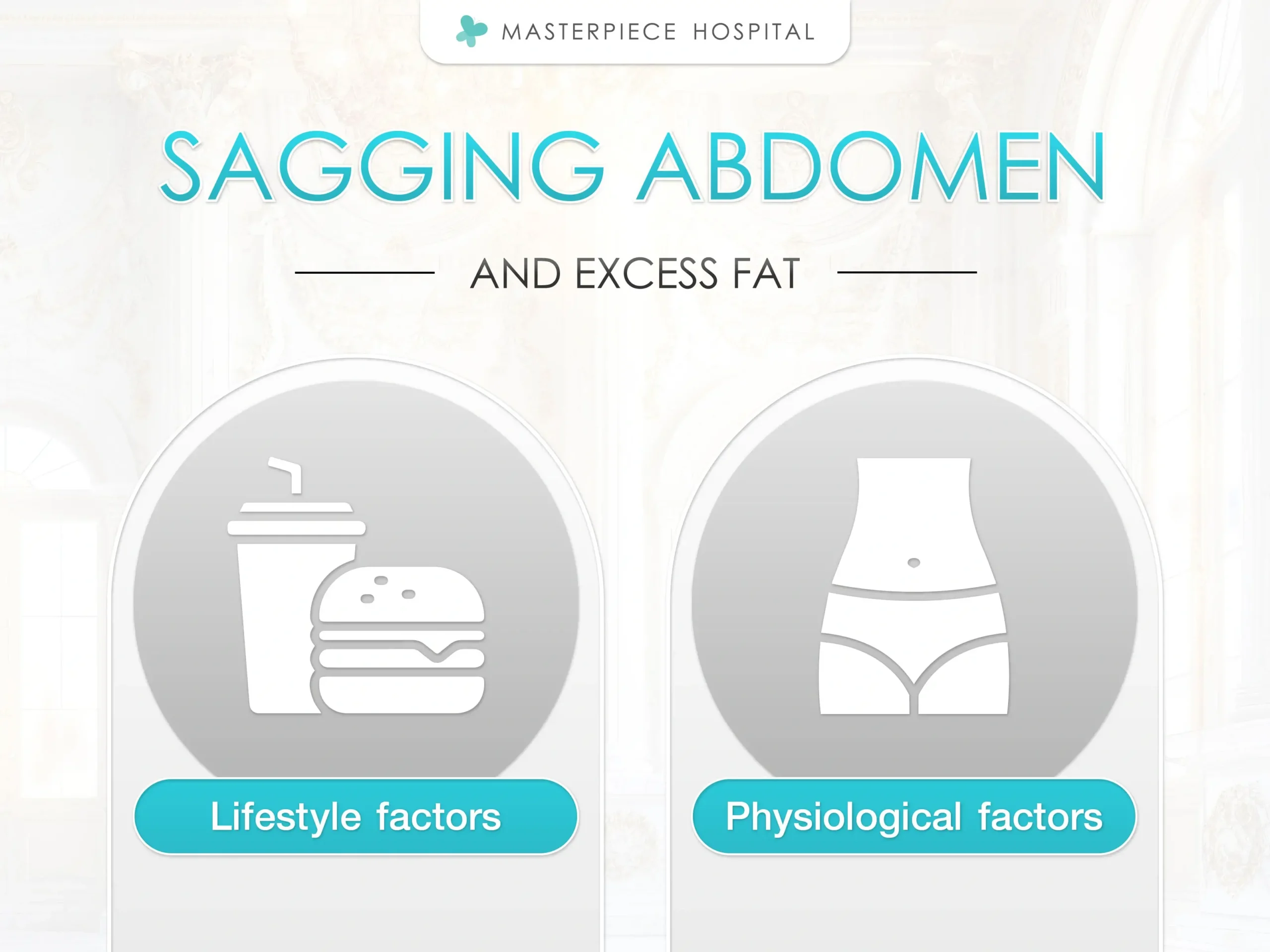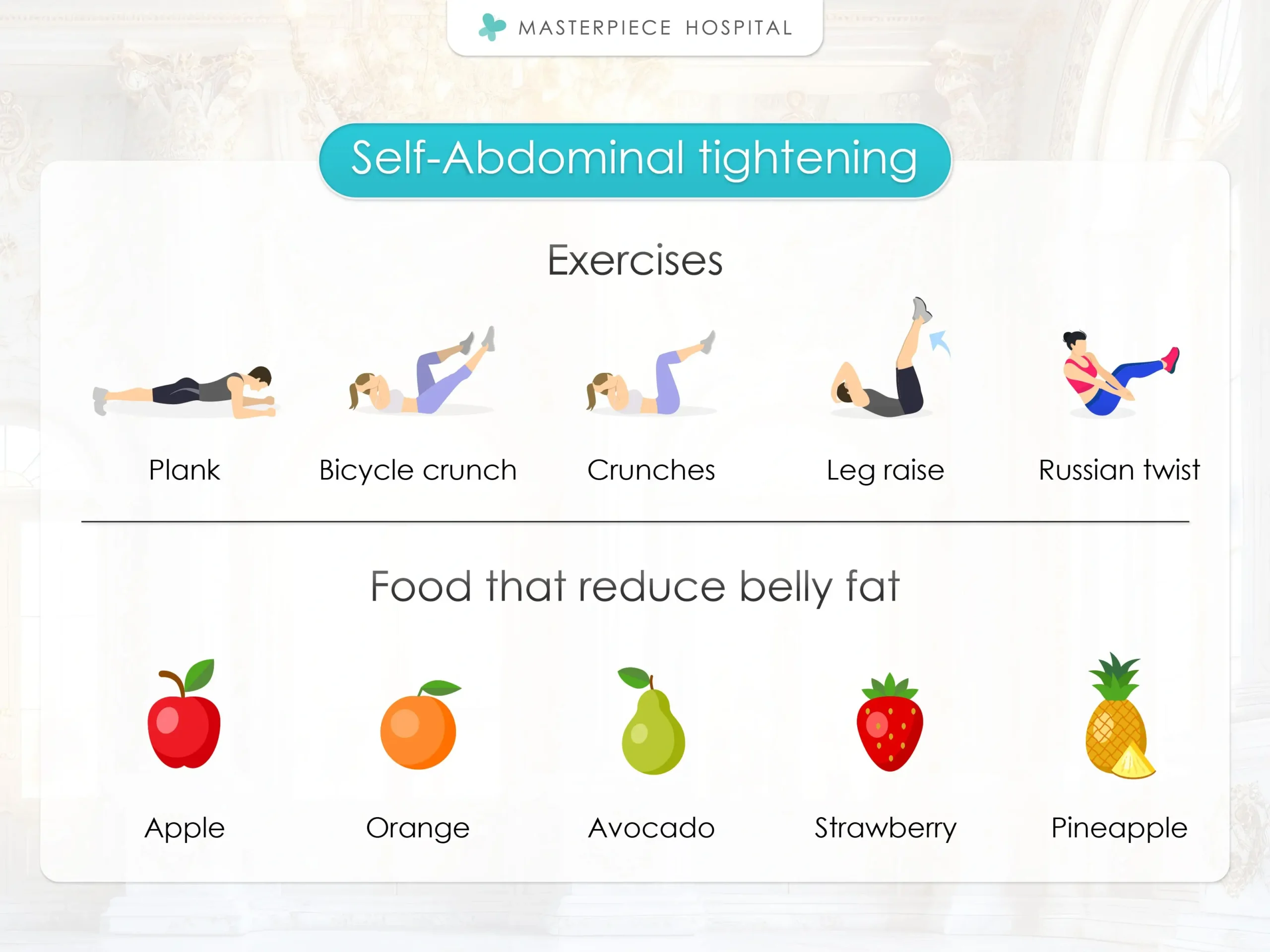Abdominal tightening: flatten the sagging belly
A sagging abdomen often causes many people to feel insecure when socializing or going out. The common idea that a flat stomach defines a good figure has led many to focus on their health and exercise to tighten their abdomen, aiming for a flat stomach and a slimmer waist. Many have even changed their daily routines and eating habits to reduce belly fat and achieve a more attractive body shape.
Why is abdominal tightening important?
A flat stomach is a sign of good health and boosts our confidence. It reflects a well-maintained body and self-care, which helps reduce the risk of future health problems. Having no belly fat can also help minimize issues that may affect both our physical and mental well-being, such as:
Effects on physical health
If we neglect abdominal health by eating carelessly and not exercising, it can directly affect our body—not just in appearance terms, but also overall health. This can lead to various diseases such as diabetes, heart disease, and high blood pressure.
Effects on mental health
Having a belly doesn’t just affect physical health, but it can also impact mental health. The current societal ideal that one must have a good figure, a flat stomach, and a slim waist to be considered beautiful can cause stress for those who struggle with excess belly fat. Many people feel pressured to reduce belly fat quickly, which can lead to anxiety and a lack of confidence, making them reluctant to face others. This often results in turning to exercise to regain confidence.

Causes of sagging abdomen and excess body fat
Having a sagging abdomen and excess body fat, leading to a protruding belly, can be caused by several factors. Someone may not realize the impact it has on their body, thinking it’s just a part of daily life. However, if broken down, it can be categorized into two main types:
Lifestyle factors
Our daily lifestyle always plays a role in our body, as both diet and habits affect the development of a protruding belly. It’s important to choose foods that are nutritious, easy to digest, and don’t contribute to fat accumulation. Additionally, incorporating regular exercise into our daily routine can help prevent negative effects on physical health.
Physiological factors
Someone may develop a belly even after eating a small amount, which could be due to physiological differences in their bodies. This may involve an abnormal Body Mass Index (BMI) or genetic factors, where family members have chronic conditions such as high triglycerides, high blood pressure, or abdominal obesity. This increases the likelihood of experiencing similar issues as those in the family.

Methods to tighten the abdomen through exercise and nutrition
If you want a flat stomach and to get rid of belly fat, there are several ways to improve your appearance. Each method has different results and may work for someone but not others, as it’s important to first understand that the cause of this issue may stem from daily habits, genetics, or the physiology of your body. Some ways to address this abdominal issue include:
Effective abdominal exercises
Not all exercises can reduce belly fat, but certain movements can help achieve a flat stomach. These include:
- Plank: Holding this position directly targets the abdomen and also strengthens the arms.
- Bicycle crunch: This bicycle-like motion helps tighten the abdomen and thighs.
- Crunches: These work on the upper abdomen.
- Leg raise: This helps reduce belly fat and inner thigh fat.
- Russian twist: This targets and tightens the sides of the abdomen.
Foods that reduce belly fat.
In addition to exercise, certain foods like fruits and vegetables can aid in reducing belly fat. Not everyone enjoys exercising, especially those who are not comfortable with it or have a larger body, so starting with a diet high in fiber can help reduce belly fat. Eating vegetables and fruits with low sugar content, while avoiding fatty foods and fried items, can be beneficial.
Behavioral adjustments to tighten the abdomen
Someone have a belly due to their daily habits, so it’s important to first get to know yourself. This includes studying your health behaviors, adjusting your sleep patterns, or checking your mental health to see if you’re experiencing excessive stress. Even drinking more water, while reducing soda, caffeine, or alcohol, can help reduce belly fat.

Tummy Truck: A quick solution for those seeking fast results without the effort
Many people who dislike exercising and have struggled with changing their habits without success may look for a shortcut to see faster results. Some opt for abdominoplasty (tummy tuck) to help with this. Others may exercise and adjust their diet but still have sagging skin, so they turn to abdominoplasty to remove the excess skin.
Who is suitable for abdominoplasty?
Abdominoplasty is suitable for various individuals, especially those who have experienced significant weight loss, as sagging abdomen skin can occur in anyone who has struggled with being overweight. For example, people who have lost weight quickly but haven’t achieved a firm body can opt for this surgery. Also, mothers after childbirth whose abdomen still protrudes despite exercise may consider abdominoplasty. However, caution is necessary as the procedure involves large incisions and can affect daily life during recovery. It can also be risky if you haven’t consulted a doctor beforehand.
Steps of abdominoplasty
The procedure varies depending on the technique used, but generally, the process involves:
- The doctor begins by assessing the location and amount of fat in the area.
- Once the assessment is complete, the doctor will administer general anesthesia and local anesthesia to prevent pain during the surgery.
- An incision is made, and the fibrous tissue between the fat layer and abdominal muscles is carefully separated. The abdominal muscles are then stitched together.
- Excess skin and fat are removed, and the remaining skin and fat layers are tightened. In some cases, the belly button may need to be repositioned.
- After the procedure, the incision is closed, and post-surgery care is provided to monitor recovery until the patient regains full consciousness.
Post-abdominoplasty care
After undergoing abdominoplasty, it’s important to follow proper self-care instructions and adhere to the doctor’s recommendations, such as:
- Avoid getting the wound wet for one week.
- For the first 1-2 weeks, avoid bending over and ensure someone is available to assist you for convenience.
- During the first 3 weeks, refrain from walking excessively, exercising, or engaging in activities that require physical effort.
- Wear the abdominal binder provided by your doctor for 6-8 weeks.
- Take medications as prescribed, and only begin light exercise once you feel better.
Risks and potential complications
After surgery, if proper self-care is not followed, complications may arise. Surgery itself carries inherent risks, and post-surgery care is crucial. Potential issues include wound infections, infections in other areas, and inflammation. Therefore, it’s important to take care of the wound by keeping it clean, and avoid exercising or heavy physical activity that could lead to further irritation or inflammation.
FAQ
Many people may be deciding whether to undergo abdominoplasty or continue exercising and controlling their habits. Therefore, we have gathered common concerns that can help make the decision easier, such as:
Summary
There are various methods to tighten the abdomen, with health-promoting approaches like exercise being beneficial as they target other parts of the body as well. Adjusting diet and lifestyle habits also supports overall well-being, including physical health, nutrition, and mental health by reducing stress. Another quicker solution is abdominoplasty, which provides fast results but requires a longer recovery time.
















